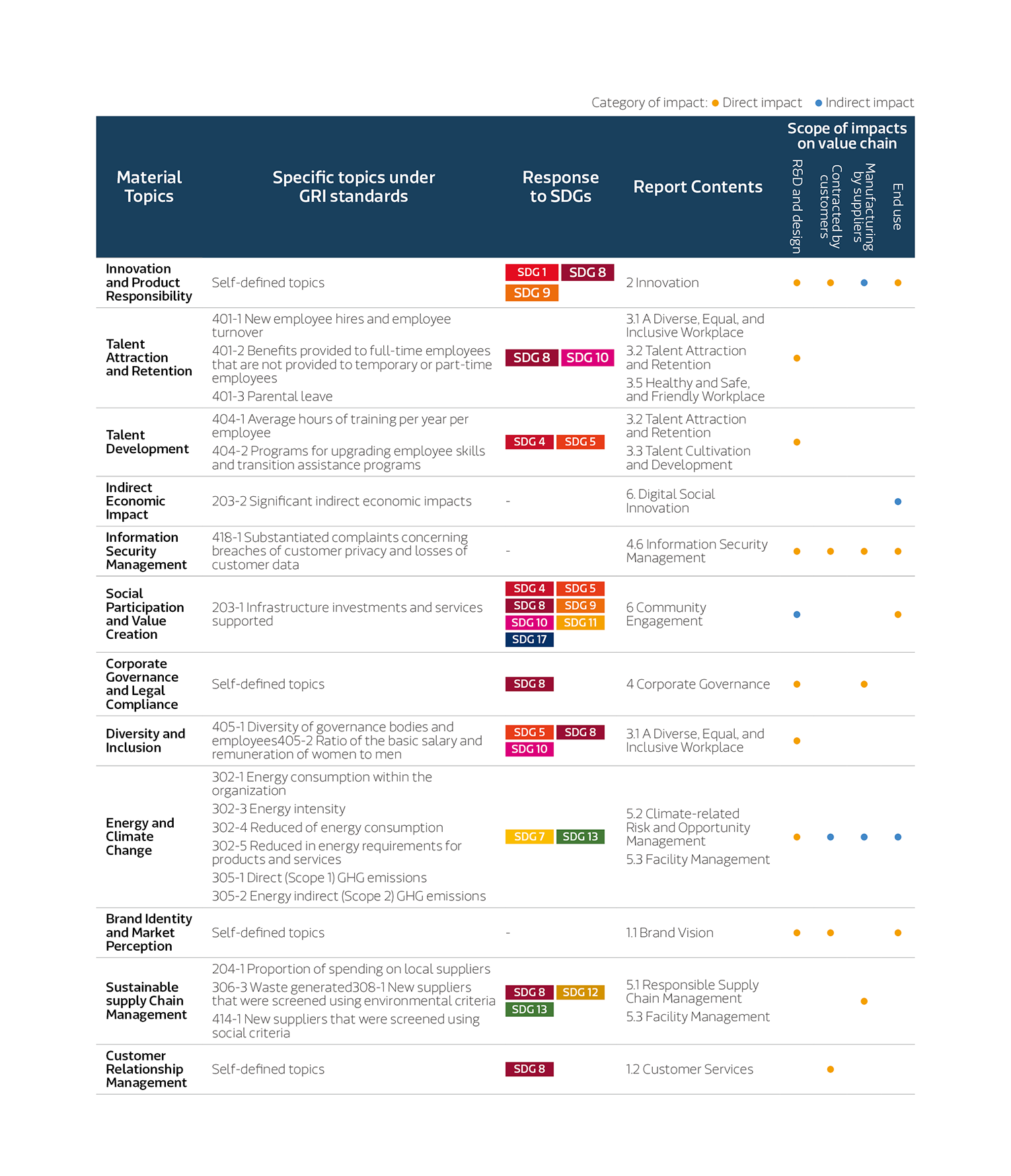Materiality Assessments
In reference to GRI Standards and AA1000 Accountability Principles, MediaTek identifies material topics based on the four major principles, namely Inclusivity, Materiality, Responsiveness and Impact, and assesses the impact of ESG issues on the economy, environment and people/human rights in accordance with GRI 3: Material Topics 2021. The results will serve as the direction of the Company's sustainability development goal, and form the basis for the Report's stakeholder responses and information disclosure.
▌Identify Stakeholders
MediaTek adopts the five major principles under the AA1000 Stakeholder Engagement Standard (SES), namely Dependency, Responsibility, Influence, Diverse Perspectives and Tension, to measure the connection and level of impact between each stakeholder and MediaTek. Six major stakeholders have been identified as communication targets, including customers, industry/government/academia/research institute, employees, shareholders and investors, suppliers, as well as the general public, consumers & media.
▌Analytical Flow for Materiality
| Benchmark analysis | Benchmarking analysis: Analyze and compile information on sustainability trends within the industry, major international sustainability rating agencies (such as DJSI, Sustainalytics, and CSR Hub), and international standards (GRI, SASB). |
| Issue identification | MediaTek has identified 23 ESG issues based on the results of benchmarking analysis, combined with the ESG issues of concern to stakeholders. Compared to the previous year, we have removed "risk management", "environmental policy" from the list and made them parts of the management mechanism, and added Biodiversity as a new sustainability issue. |
| Material Topics Selection | MediaTek conducted materiality assessment in 2024, identifying key topics through three dimensions: "assessment of impact on sustainability," "assessment of impact on organizational operations," and "stakeholder concerns". These served as the criteria for selecting material topics. 【A】 Assessment of impact on Sustainability: ESG Committee's working groups first assess with final confirmation by senior management. 【B】 Assessment of impact on organizational operations: Internal senior managers evaluate the level of impact each sustainability issue would affect the Company's operations and rank their importance accordingly. 【C】 Stakeholder concerns: We survey key stakeholders to understand their concern for each sustainability issue. The analysis of material topics are conducted every two years. However, if a significant event or a major change in circumstances does occur, we will re-conduct material topics during the upcoming reporting period. We approach these surveys with careful consideration, using the latest findings to confirm the results of past measures and new material topics. We respond to stakeholders proactively by establishing diverse engagement channel under the routine operation framework. |
| Sustainability Impact Assessment | After completing the survey, the ESG Committee further assesses how the Company's operations, through these ESG issues, impact the economy, environment, and people/human rights. This includes evaluating the level of positive/negative impact and the actual/potential likelihood of occurrence. We would then rank these issues based on their impact levels. |
| Confirming of Material Topics | The ESG Committee established the matrix of material topics using 【A】 "Sustainability Impact Assessment" and 【B】 "Organizational Operation Impact" as foundations, then fine-tuned the materiality ranking by considering 【C】 "Stakeholder Concern Level". Based on communication and survey results, the ESG Committee's working groups analyze root causes and develop corresponding measures. The results will be presented to the CEO for final confirmation during the work meeting for the first half of the year. In line with GRI 3-3 reporting requirements for managing material topics, details such as the corresponding measures, short-to-long-term goals, annual achievements, and management approaches for each material topic would be outlined in the report. In 2024, there are 12 material topics in total. The matrix and list of material topics are as follows: |
▌Scope of and Impact on Value Chain
MediaTek is an IC design company without any production line. It is positioned at the forefront of the overall value chain and engaged in main business lines including R&D, design and sales of products, or customization commissioned by customers. Before the product is completed, the back-end raw material procurement, manufacturing, packaging and testing are executed by suppliers independently. The following refers to the review on the scope of impacts posed by each material topic to the value chain. The scope of impact is shown as follows:
▌Assessing and Ranking the Impact of Material Issues
After material issues are finalized, each working group of the Sustainability Committee would evaluate the impact of 11 major issues on the economy, environment and people/human rights, including positive/negative impact and actual/potential likelihood. Impact is then ranked based on the results of evaluation, while the responding measures, short-, mid- and long-term goals, annual results and management guidelines are presented in the report, in accordance with the requirements of GRI 3-3 Management of material topics.
▌Impact Assessment
The materials issues are scored from low, moderate to high based on their impact on the economy, environment, people/human rights. Likelihood of occurrence is categorized into low, moderate, high and existing The results of assessment and summary done by each working group are as follows:

For further details, see the “Analysis of Material Topics” section of the 2024 MediaTek ESG Report.